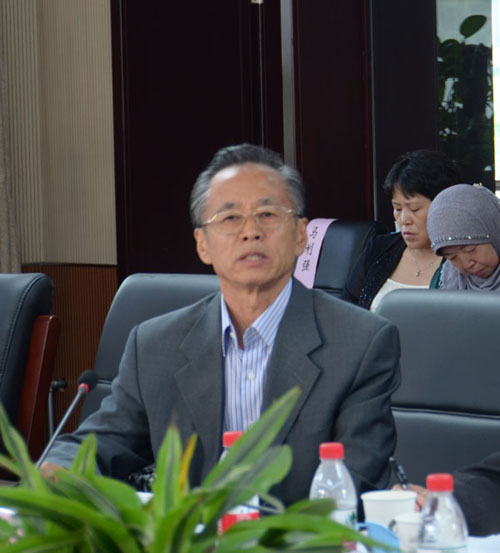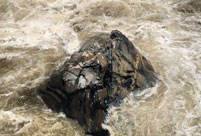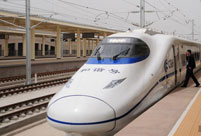 Luoyang aims to become 'Chinese Culture City'
Luoyang aims to become 'Chinese Culture City'
 Century-old jade disc found confirms ancient legend
Century-old jade disc found confirms ancient legend
 A serious mind behind Chinese leader
A serious mind behind Chinese leader
 Panda Cubs to Predict 2014 World Cup Winners
Panda Cubs to Predict 2014 World Cup Winners
 China Southern Airlines flight attendants win titles in service contest
China Southern Airlines flight attendants win titles in service contest
 Pupil's performance art persuades people to stop smoking
Pupil's performance art persuades people to stop smoking
 Nie Chenxi's clay tigers
Nie Chenxi's clay tigers
 Children's Day wishes
Children's Day wishes
 Chinese Kung Fu charms Silicon Valley
Chinese Kung Fu charms Silicon Valley
 Tranquil Yankou ancient town
Tranquil Yankou ancient town
 |
| Liu Zhentang, former Chinese Ambassador to Iran, delivers a speech at the seminar in Beijing Huimin School, June 3, 2014. (People's Daily Online/Du Mingming) |
"Iran plays an important role in the two-thousand-year history of the Silk Road, and its unique status remains irreplaceable even today," said Liu Zhentang, former Chinese Ambassador to Iran, at a seminar in Beijing last Tuesday.
The "21st century China-Iran Silk Road Seminar", jointly hosted by the Cultural Counsellorship of Embassy of Islamic Republic of Iran, the Donggan (Hui ethnic group) Central Research Institute at Minzu University of China, Beijing Ethnic Education Association, and Beijing Huimin School, involved nearly 50 experts, scholars, and representatives from China and Iran.
Liu explained his idea as follows:
Firstly, it is commonly accepted that Xi'an was the starting point of the Silk Road, and the end was Rome. Persia was located in the middle, which served as a bridge to link the two sides. A large number of Chinese archaeological discoveries have confirmed this point. More than 95 percent of foreign coins unearthed in China date from Persia's Sassanid Dynasty (3rd century to the 7th century AD).
Secondly, Persia was a country rich in religions. Almost all the religions associated with Persia spread to China. The Persians even brought certain religions that did not originate in Persia to China. For instance, Persian Zoroastrianism and Manichaeism had considerable influence in China, and Persians were the main force in spreading Nestorianism and Islam to China.
Thirdly, Quanzhou, a historical city in south China's Fujian Province, was an important link in the traditional maritime Silk Road. Quanzhou was once a key port on the maritime spice road and the Silk Road. More than half of the sarcophagus, steles, and carved relics stored in Quanzhou Maritime Museum were written in Persian. In addition, there is a well preserved Manichaeism statue standing on a cliff in Quanzhou.
Liu pointed out that although China and Iran have different systems and beliefs, the two countries share common universal values: mutual respect, fairness and equality, independence, mutual benefit and win-win, and opposition to any form of power politics and hegemony. He said that such values should be true universal values.
"The relationship between China and Iran is a strategic partnership with no written agreement, and Iran will play a more important role in building the new Silk Road," Liu remarked.
 Magnificent Hutiao Gorge
Magnificent Hutiao Gorge  Heat waves hit China
Heat waves hit China Love at the construction site
Love at the construction site Graduation photos bring memories back to life
Graduation photos bring memories back to life Art school students present works in Nanjing
Art school students present works in Nanjing Xinjiang's first high-speed railway goes on trial run
Xinjiang's first high-speed railway goes on trial run 3D Sea-life Themed Art Garage unveiled in Zhengzhou
3D Sea-life Themed Art Garage unveiled in Zhengzhou
 Creative Photos go viral during graduation season
Creative Photos go viral during graduation season Students in last-minute effort for Gaokao
Students in last-minute effort for Gaokao Dali, an ideal summer vacation destination
Dali, an ideal summer vacation destination Xichan Temple's little monk hit the Internet
Xichan Temple's little monk hit the Internet Monologue of a modern dancer
Monologue of a modern dancer College girl proposes to boyfriend on Weibo
College girl proposes to boyfriend on Weibo Special operation members in counter-terrorism training
Special operation members in counter-terrorism training American football brings manhood out of boys
American football brings manhood out of boysDay|Week|Month